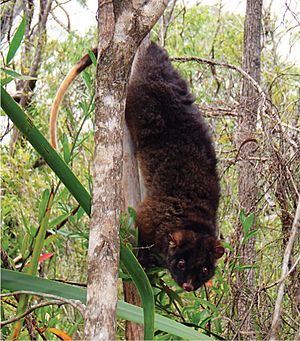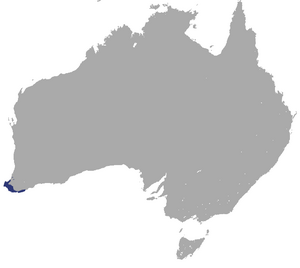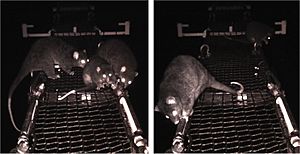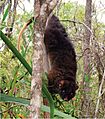Western ringtail possum facts for kids
Quick facts for kids Western ringtail possum |
|
|---|---|
 |
|
| Conservation status | |
| Scientific classification | |
 |
|
| Western Ringtail Possum range | |
| Synonyms | |
|
Pseudochirus occidentalis Thomas, 1888 |
The western ringtail possum, also called ngwayir, is a type of possum. It is found only in a small part of Southwest Australia. These possums are about the size of a cat. They have thick, dark grey-brown fur, light-colored bellies, and a long tail that can grip things, with a white tip.
Ngwayir look for food at night in the tops of trees. They eat young leaves, flowers, and fruit, especially from Agonis flexuosa trees, also known as weeping peppermint. They usually have one baby in winter. The baby stays in its mother's pouch for about three months.
Sadly, the number of western ringtail possums has dropped by more than 95% since people from Britain settled in Australia. This is because their homes were destroyed, fires happened, and red foxes were brought in. Because of this, the western ringtail possum is now listed as Critically Endangered. Most populations have almost disappeared, but some strong groups still live in cities like Busselton and Albany.
Contents
Discovering the Western Ringtail Possum
The western ringtail possum was first described in 1888. A scientist named Oldfield Thomas wrote about it. He studied specimens at the British Museum of Natural History.
At first, the animal was called Pseudochirus occidentalis. Later, its name was corrected to Pseudocheirus occidentalis. Some people think it is a separate species. Others believe it is a type of the common ringtail possum, P. peregrinus, which lives in Eastern Australia.
This possum has many local names. These include ngwayir, womp, woder, ngoor, and ngoolangit. These names come from the Noongar language.
What Does the Western Ringtail Possum Look Like?
The western ringtail possum is a type of Pseudocheirus possum. They are about the size of a house cat. They have strong bodies and legs. Their feet are good for climbing trees.
Their back slopes down towards their tail. The tail is long and can grab onto branches. It ends in a thin, white tip. These possums are about 32 to 40 centimeters (12.6 to 15.7 inches) long, not including their tail. Their tail is also 30 to 40 centimeters (11.8 to 15.7 inches) long. They weigh between 850 and 1000 grams (1.9 to 2.2 pounds). Some can weigh up to 1300 grams (2.9 pounds).
Western ringtail possums have dark grey-brown fur. They have lighter patches behind their ears. Their belly, chest, and throat are creamy white, sometimes greyish. They do not have the reddish fur that common ringtail possums in eastern Australia have.
Where Do They Live?
The western ringtail possum lives only in the southwest of Western Australia. They are now found in small areas of eucalypt forests. These areas are between Two Peoples Bay and the Collie River. The furthest inland they are found is at Perup.
These possums prefer coastal forests. These forests still have many Agonis flexuosa (weeping peppermint) trees. They also like eucalypt forests that have not been heavily logged or affected by modern fires. Some of the best places for them are in city gardens and parks in Busselton and Albany. Here, they are safer from fires and foxes.
Studies in Albany show that each possum uses an area of about 0.88 hectares (2.2 acres). They rest in their nests during the day. At night, they move to eucalypt trees to find food. How much space they need depends on how much tree cover there is.
In 2019, more studies found them in sheoak woodlands. These woodlands have Allocasuarina fraseriana trees. While they are more common in jarrah and Eucalyptus staeri woodlands, finding them in sheoak areas was new.
Their home range has shrunk by over 90% since the early 1800s. This is due to big changes in the environment. Many mammals in Australia have become extinct. The possum populations became separated as cities grew. Inland populations, once numbering hundreds of thousands, dropped by over 99% by 2009.
Behaviour and Diet
The western ringtail possum lives in trees and is active at night. It is a herbivore, meaning it eats plants. They have a small home range, usually 0.5 to 6 hectares (1.2 to 14.8 acres). This depends on where they live.
They use tree hollows for shelter. They also build nests called dreys in tree branches. These nests are made from shredded bark, twigs, and leaves. They mostly stay in trees. However, they will move on the ground if the tree branches are not connected. Sometimes, they even use rabbit burrows for shelter, but this is rare.
Pseudocheirus occidentalis eats leaves, shoots, fruit, and flowers from many plants. Their favorite food trees are jarrah (Eucalyptus marginata) and marri (Corymbia calophylla). The weeping peppermint (Agonis flexuosa) is their most preferred food.
The quality of weeping peppermint leaves is better in forests that have not had intense fires. These leaves have more nutrients and fewer toxins. Possums prefer young leaves because older leaves have more tough fibers.
These possums also eat their own droppings. This helps them get more nutrients from their food.
Life Cycle
Western ringtail possums usually have one baby. Births mostly happen in winter. The young possum stays in its mother's pouch for about three months. When they leave the pouch, they weigh around 125 grams (4.4 ounces). They continue to drink milk until they are 6 to 7 months old. By then, they weigh about 550 grams (1.2 pounds).
In jarrah forests, western ringtail possums can live up to four years. On the Swan Coastal Plain, they can live up to six years. One female possum in a care facility lived for nine years.
Possums sometimes try to cross roads to find food. This often leads to them being hit by cars. To help, people have built rope bridges for them. These bridges allow possums to cross roads safely. A study near Busselton showed that possums started using a rope bridge soon after it was built. They used it about nine times a night. Young possums also learned to use it by following their mothers. These bridges help reduce deaths and keep possum groups connected.
Protecting the Western Ringtail Possum
The number of western ringtail possums has gone down a lot. This is because their homes have been destroyed. Also, red foxes, which were brought from Europe, hunt them.
Today, the main threats are still losing their habitat and being hunted by introduced animals. Big fires also cause problems. Intense fires destroy safe places and food sources, which can lead to starvation.
In 2017, the International Union for the Conservation of Nature (IUCN) looked at the possum's status. They classified it as critically endangered. This means it is at very high risk of disappearing forever. At that time, there were only about 3400 possums left. The state of Western Australia also lists them as endangered. National laws recognize them as critically endangered.
Images for kids






